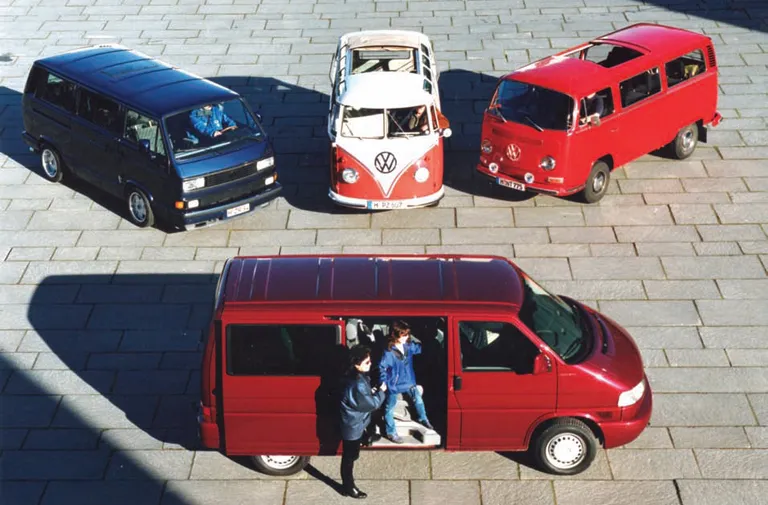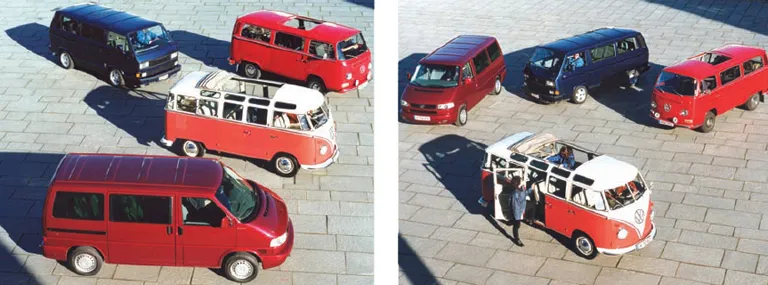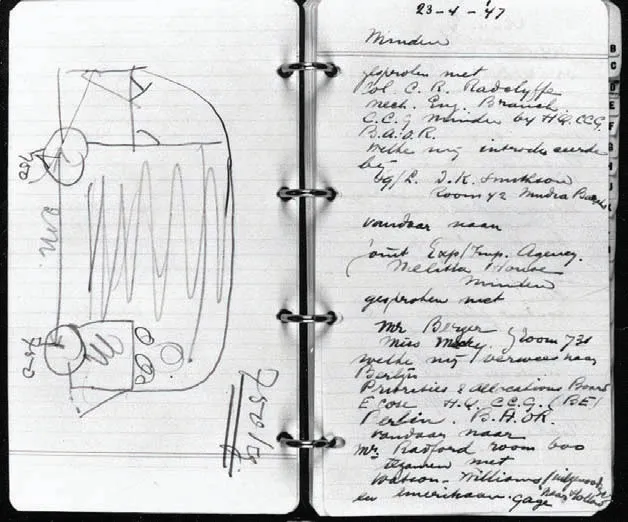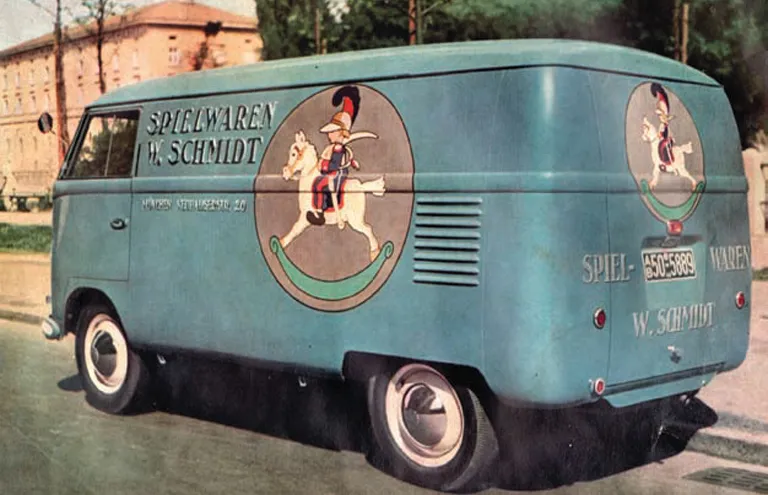![]()
Volkswagen’s marketing department produced a wealth of celebratory material to mark the occasion of the Transporter’s fortieth anniversary in the year 2000. A series of publicity images portrayed all four generations, each in top-of-the-range passenger guise. Of the T4’s ancestors, prominence was given to the original version, which as a Micro Bus De Luxe was produced between 1952 and the summer of 1967. Photos: Volkswagen
1before the fourth-
generation Transporter
Inevitably, any manufacturer, Volkswagen included, will endeavour to make as much as possible out of the launch of a new model. Increasingly specific and steadily more frequent pre-launch press releases, each full of carefully calculated hyperbole and a wealth of classy, striking images, will be issued free to journalists for editorial purposes. Then a centre-stage appearance at the most prestigious of the merry-go-round of motor shows will be arranged, and lavish test-drive schedules put in place for carefully selected individuals capable of spreading the positive word to a wide audience. All these are central to the advance generation of the very maximum of favourable publicity to aid the dealerships and their eager, smart-suited salesmen in selling the product.
The T4’s carefully manicured path to an official launch on 15 September 1990 proved no exception to the marketing rule book, at least in terms of the plans co-ordinated to give the latest Transporter the best possible start in life. However, while it was not exactly a damp squib, the new model lacked the cutting edge anticipated of its predecessors and so beloved of journalists. The reason was straightforward. The launch of the first-generation Transporter had announced a totally new concept to a market eager to embrace the latest technology. That of the second generation had offered a completely upgraded version of Volkswagen’s second best-selling model against what was perceived by critics to be an operation headed by an individual incapable of changing designs. Then, with the third generation a vehicle had been presented that defied the mood of the times through its retention of both an air-cooled engine and a location for that power unit at the rear of the vehicle.
In comparison to such momentous events, the new fourth-generation Transporter was almost blandly conventional. Its similarity with the offerings of other manufacturers was perhaps partly dictated by the now well-established, and almost taken for granted, new-look Volkswagen and its range of vehicles, which sported both water-cooled engines and a front-wheel-drive arrangement.
Ben Pon’s hastily scribbled sketch of his idea for a small commercial vehicle. Photo: Volkswagen
PON’S SKETCH
Many an official Volkswagen chronicler will advise the unwary enthusiast that the birth of the Transporter was a straightforward affair involving an opportunist Dutchman and a British army Major. The Pon family in Holland had chosen to quit as Opel Dealers following US giant General Motors’ acquisition of the German firm in the 1930s. There then followed a prolonged period when Ben Pon battled to acquire the Beetle as a new mainstay for the family business. Thwarted in his attempts in the Nazi era, when the Third Reich was crushed and consigned to a dark and dismal dungeon of history, and Germany was under the benign wing of the Control Commission for Germany, Pon set about his task once more with relish and soon captured the attention of the Senior Resident Officer at Wolfsburg, Yorkshireman Major Ivan Hirst.
On one of his not infrequent visits to Wolfsburg, Pon came across a mode of transport that had been endowed with the name Plattenwagen (literally ‘flat car’), a rudimentary vehicle designed by Hirst for the purpose of moving items from one part of the damaged factory to another following the army’s request to retrieve vehicles it had loaned to Wolfsburg for just such purposes. Pon immediately saw the potential in exporting this vehicle to Holland, but the idea was firmly thwarted by the Dutch Transport Authority – the Plattenwagen’s design, where the driver sat at the rear of the vehicle, flouted just about every rule in the infant health and safety book.
Still, the Plattenwagen had triggered a thought in the entrepreneurial Pon’s ever-fertile mind and, on his visit to Wolfsburg on 27 April 1947, he hastily scribbled the outline of a small commercial vehicle inspired by the ‘flat car’. The essence of his creation was a box-shaped structure designed to carry loads of up to 750kg. The driver and any accompanying passengers sat over the front wheels, while the engine was at the rear, carefully mounted above the axle and easily accessible via a large lid at the rear of the vehicle.
Historians employed by, or under the influence of, Volkswagen since the late 1960s proclaim Pon’s sketch as denoting the birth of the Transporter and anniversary celebrations relating to the date of the drawing are assiduously organized with an appropriate degree of razzamatazz. However, there is a fundamental flaw in the theory. Hirst took Pon’s delivery van idea to Colonel Charles Radclyffe, his superior officer based in Minden and the military government’s servant charged with responsibility for light engineering in the British occupation. Faced with falling production numbers for the Beetle, a car increasingly saddled with a dubious reputation for reliability due to a lack of quality in its components and build, and a factory that two years after the cessation of hostilities still lay more or less derelict, Radclyffe rejected the proposal. His main concern was that both additional manpower and extra resources would be required to bring it to fruition, when clearly Wolfsburg was already overstretched.
THE APPOINTMENT OF HEINZ NORDHOFF
Despite the perilous state of the Volkswagen factory, it was decided as part of a wider plan for Germany’s future that there were sufficient grounds to believe it could prosper in the right hands. Berlin lawyer Hermann Münch, who had been appointed to look after the factory as custodian in the absence of a legal owner, knew little or nothing about the business of making cars. Any ideas that Ivan Hirst might have had concerning a permanent position at Wolfsburg, something he would later dismiss as the fantasies of over-active minds, were overlooked. Long-term occupation of Germany was never a serious consideration. Wolfsburg needed an expert car maker either as deputy to Münch or, more realistically, to replace him. Colonel Radclyffe recognized the management skills of one Heinz Nordhoff, a former director with Opel and during the war Director General of the Opel-Werke in Brandenburg, which by that time was the largest truck-making plant in Europe. After thorough training in Detroit, Nordhoff was fully versed in both modern sales and production techniques. He was dynamic in pursuit of his goals and had an insatiable desire to fill his days with tasks; in truth, he was a workaholic.
Heinz Nordhoff, Volkswagen’s Director General, 1948--68. It was his drive and determination that ensured that by late 1949 the Beetle was no longer VW’s only product. Photo: Volkswagen
Nordhoff’s appointment as Director General heralded Volkswagen’s rapid climb to become the fourth-largest car manufacturer in the world and producer of a vehicle that sold in its millions under his custodianship. This has been a dominant theme of many a history of Volkswagen but far less well known is Nordhoff’s pivotal role in the birth and development of the Transporter.
LAUNCHING THE NEW MULTI-PURPOSE TRANSPORTER
On 12 November 1949, before an assembly of specially gathered motoring journalists, Director General Nordhoff announced the arrival of a second Volkswagen model to join the Beetle. By this time Nordhoff had already secured the Beetle’s future by adding a De Luxe or Export model to the basic saloon, while Ferdinand Porsche’s original idea of producing a soft-top version of the car had come to fruition in the form of a four-seater Cabriolet assembled by Karmann of Osnabrück and a two seater Coupé created by Wuppertal-based Hebmüller. Beetle production was destined to jump from the paltry 8,987 units produced in 1947 under the auspices of the British to 46,146 vehicles by the end of 1949. From then on, numbers would escalate year by year until the mid-1960s, at which point more than one million cars were produced in a 12-month period.
The new Volkswagen model, the work of Heinz Nordhoff and his development manager Alfred Haesner, was conceived in the latter months of 1948, well before financial stability was assured. As such, although the essence of the concept remained intact throughout, compromises had to be made. The most notable of these was an initial reliance on the Beetle’s backbone chassis, a decision that had disastrous consequences as the first prototype broke its back under the stress of the load placed on it for an initial test drive. Some would argue that the borrowing of the Beetle’s 25PS engine for the much larger Transporter was another sign of the lack of funds, which prevented the production of a more appropriate engine. Countering this, others note that it was not until the 1960s that the Transporter was endowed with a more powerful engine than the Beetle, that is to say, long after Wolfsburg’s vaults were filled with the spoils of the ever-increasing sales that had followed Volkswagen’s rapid and unrelenting expansion into the markets of over 100 countries worldwide.
Nordhoff’s lengthy speech to the press at the launch of the first-generation Transporter was a carefully crafted piece of oratory, deft in emphasizing the revolutionary nature of much of the information imparted, while encompassing all the subtleties required to ensure that the new product benefited from maximum exposure. His exposé of the Transporter started with the revelation that Volkswagen had not just launched into the project without considerable forethought; indeed, exhaustive market research amongst those with a potential interest in such a vehicle had been carried out:
Early Delivery Vans lacked both a rear window and bumper. Many were finished in Dove Blue, as per this example. The chrome rather than painted hubcaps are an extra-cost option. Photo: Volkswagen
We arrived at the conclusion that it was not the typical half-tonner on a car chassis that was required, but a 50 per cent bigger three-quarter-tonner with as large as possible a load space; an enclosed van which can be used in many different ways. A half-ton payload is the largest that can be accommodated on a medium-sized car chassis, even with stronger suspension and bigger tyres, and hence the 500kg payload of all vehicles of this type. The situation immediately becomes clear when you look at a schematic drawing of a typical example of this type of van on a car chassis. The load area lies completely over the rear axle, which carries practically the entire payload and therefore soon reaches its natural limit. It also causes a very undesirable distribution of axle load, with strong dependence on the distribution of the load, and therefore negative effects on the suspension.
Having summarized what was wrong with vehicles already on the road and confirmed the futility of Volkswagen trying to emulate such defective designs (as Ferdinand Porsche appears to have attempted in the Nazi area, w...





